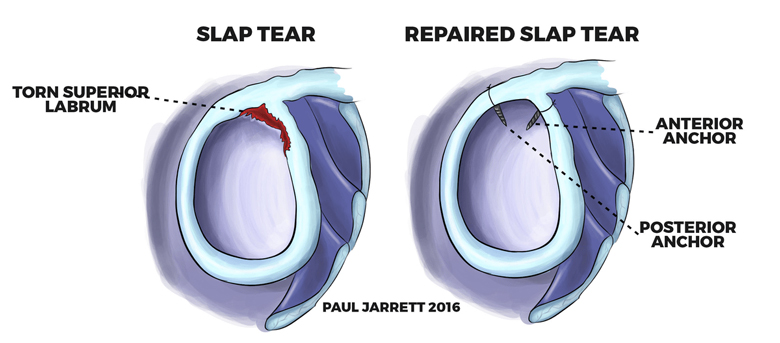
Biceps Tendon Pathology
At the pulley and the tunnel where the long head of biceps tendon exits the glenohumeral joint to enter the arm, tears of the supporting structures, tears within the tendon or inflammation of the tendon (bicipital tendonitis) can cause pain in the shoulder, radiating down into the arm. This is usually worse with shoulder use.
For some patients, the pain may be episodic, but it is more often persistent. The area where the long head of biceps tendon inserts into the labrum at the top of the glenoid may tear in some patterns, and this is called a SLAP tear. SLAP stands for Superior Labrum Anterior Posterior tear (which only means at the top of the labrum, front and back). This most commonly occurs as a result of injury, and symptoms consist of pain high up or in the shoulder, often with a clicking noise and pain when using the shoulder overhead. A SLAP tear can, however, develop due to degeneration within the labrum and may not be responsible for any symptoms. Sometimes the long head of biceps ruptures spontaneously at the level of the tunnel. The result is a pain in the shoulder, usually with some bruising for a small number of weeks, and some initial shoulder weakness and stiffness which resolves over some weeks. The biceps muscle most commonly changes shape permanently due to the rupture, with the biceps muscle being more prominent further down your arm (slightly like Popeye, the sailor). Some patients have suffered from symptoms of biceps tendonitis before the tendon rupturing, and the rupture causes the tendonitis symptoms to disappear. It is usual to treat a ruptured long head of biceps tendon with painkillers, and if required, physiotherapy. Surgical repair is not usually performed unless a rupture occurs in a patient who is under the age of 50 and performing a job involving heavy lifting such as a manual labourer, or a patient who is a throwing athlete whose rupture has been diagnosed shortly after injury, because surgery confers little advantage for most patients and has a long recovery period.
How is biceps tendon pathology treated?
Painkillers and reducing the activities causing the symptoms can be useful for the above conditions, and steroid injections can also be considered for biceps tendonitis. If symptoms from the biceps problem in the pulley or in the tunnel do not settle in time, then surgical release of the tendon (Biceps Tenotomy) or release of the tendon and reattaching the tendon into the bone in the area of the tunnel or more commonly just a little lower in the top of the arm (Biceps Tenodesis), can be considered.
Biceps Tenotomy
Biceps Tenodesis
Biceps Tenotomy
It is possible to consider releasing the long head of the biceps tendon because the biceps muscle has an additional tendon attachment in the shoulder, the short head of biceps. However, in approximately half of patients, the shape of the biceps muscle will change after a biceps tenotomy.
Biceps Tendon Pathology Treatment 31 If this shape change occurs, it changes the cosmetic appearance of your arm, but usually does not cause any function problems, although there is a small risk of future biceps muscle cramping or aching. From a patient’s point of view, a biceps tenotomy allows for a relatively rapid recovery from surgery. The operation, aftercare and recovery time is relatively similar to that of a subacromial decompression. (Please see the subacromial decompression post-operative care section).
Biceps Tenodesis
In this operation, the chance of a change in shape of the biceps muscle is considerably less compared to a biceps tenotomy, although it can still change shape. The recovery after a Biceps Tenodesis is significantly longer than that required for simply releasing the tendon without repairing it back into the bone. A sling is worn for four weeks after the tenodesis with no heavy activities for twelve weeks.
The surgery, aftercare and recovery time is relatively similar to that of a rotator cuff repair from a patient’s point of view (please see the rotator cuff tear post-operative care section). Some patients following a biceps tenodesis get aching at the repair site for many months, and occasionally long term.
If a SLAP tear does not settle with rest and painkillers, surgery could be considered either in the form of a biceps tenotomy or biceps tenodesis (see above) or arthroscopic labral repair, depending upon the tear, your symptoms and your age. Labral repair uses procedures similar to those for shoulder instability (please see section on shoulder instability for details on the surgical care of labral tears).
